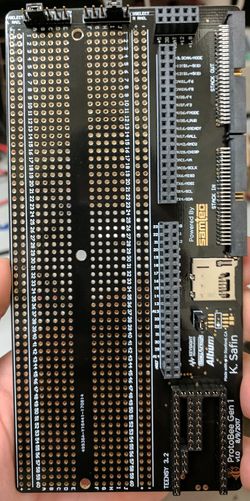Difference between revisions of "Balloons Gen 1 ProtoBoard"
| Line 1: | Line 1: | ||
{{HONEY-sidebar | {{HONEY-sidebar | ||
| header = ProtoBee | | header = ProtoBee | ||
| + | | img link = File:ProtoBee.jpeg | ||
| designer = Kirill Safin | | designer = Kirill Safin | ||
| techline = Balloons ProtoBoards | | techline = Balloons ProtoBoards | ||
Revision as of 22:20, 23 August 2017
| ProtoBee | |
|---|---|
| Part of the HONEY Architecture series & the HABEES series | |

| |
| Chief Designer | Kirill Safin |
| Technology Line | Balloons ProtoBoards |
| Version | Generation I |
| Name | ProtoBee |
| General | |
| HONEY Standards • Venom Breakout • Fang Breakout • Board Naming | |
| Core Software | |
| STINGR | |
| Core Avionics | |
| The Count | |
| Core Power | |
| Biscuit | |
| Core Peripherals | |
| Cobra • Viper • ProtoBee | |
| Core Radio | |
| Macaw | |
| Test & Prototype | |
| QueenBee | |
| Guides | |
| Making a HONEY Board • Using STINGR • Using QueenBee • Making a Prototype | |
| V • E | |
ProtoBee is the name for HONEY ProtoBoards -- that is, ProtoBee is a solderable prototyping board that is integrated with the HONEY flight stack. ProtoBee allows for flexible and quick circuit designs, projects, and sensors to be tested (and connected to the HONEY stack) without necessitating the creation of an actual HONEY compliant PCB.
Operation
ProtoBee is very simple and straightforward to use.
Breadboard
ProtoBee includes a baked-in full-size solderable breadboard to solder-down the particular projects/circuits being tested or flown. This breadboard, like the one found on Cobra, also includes the ability to directly apply a voltage to each power rail using a jumper and a set of headers at the top of each set of power rails.
In a Protobee, you may choose between applying raw cell (4.2V), 12V, 3.3V, and 5V to each power rail (individually). It is worth noting the 3.3V supply in this case is from the on-board Teensy 3.2 -- if there is no Teensy 3.2 installed, this net is floating.
The selection-header is 6 pins wide. The second pin from each end connects directly to the power rail. The first and third pins from each end are a particular voltage. Therefore, to select a voltage, you must jump together either the: 1st & 2nd pins, 2nd & 3rd pins, 4th & 5th pins, or 5th & 6th pins. Be careful not to accidentally jump the 3rd & 4th pins -- which can permanently damage the HONEY BMS.
It is worth noting that the headers for the left & right power rails are mirrored.
Payload Breakout
ProtoBee is equipped with two Venom Breakout connectors. If using one ProtoBee on a given flight, simply connect the "STACK IN" Venom Breakout to the Viper board of the flight stack -- this will effectively provide all power & data signals from the stack to your ProtoBee.
In the case of two or more ProtoBees, one can connect the flight stack to the STACK IN connector, then connect the second ProtoBee to the "STACK OUT" connector of the first -- daisy chaining them together. This allows combining any number of ProtoBee's together, with only one cable going to the main fligh stack.
The Venom Breakout is broken out onto a set of headers, which can then be used for the project being tested on the ProtoBee. There are two options for how to utilize this -- one can either solder down a set of vertical male headers, to allow the use of female-male jumpers for testing & changing things easily, OR one can forego soldering male headers down, and instead use breadboard jumper wires to solder directly from the breakout to the breadboard.
The latter is encouraged for well-designed systems that want to be very solid and ready for flight; however, understandably, many systems are to be tested and might have issues, and a more flexible arrangement using headers & jumper wires may be preferrable.
Additionally, the HONEY Power Bus is broken out onto its own dedicated set of 2x6 headers, to be used as needed, in the same manner.
The pinout for the breakout is well designated on ProtoBee for reference. To understand the functionality of each signal, see the HONEY spec.
Teensy 3.2 Socket
ProtoBee includes a socket that fits a Teensy 3.2 MCU, for projects that require or would benefit from a microcontroller. By default, the Teensy already comes with a micro SD data logger and a CAN Transceiver -- this allows the Teensy to communicate with the Flight Stack over CAN, as well as provides the ability to log any data you may have. The consequence is that there are three pins that are reserved for these purposes (2 for CAN, one for Micro SD).
All pins of the Teensy are broken out onto a 2-row header connector. This can be implemented much like the Stack breakout header rows. One can solder in male header pins to allow using of jumper cables for flexibility, or solder breadboard wires directly between the breadboard and the breakout pins. Either solution is acceptable depending on the requirements of the project.